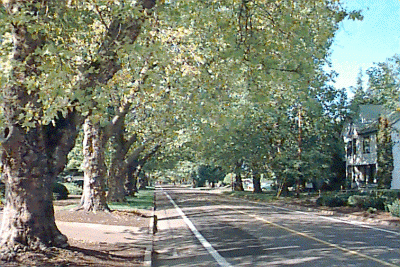Historic Walking Tour - Jefferson Street Trees
Significance
The Jefferson street canopy of 36 trees (about 75 years old) is a strong image in Corvallis and is a reflection of Corvallis' past when many streets were tree lined. It is unusual to find trees of this maturity and visual effect on a city street. Possibly the only other street in Corvallis that compares is west Harrison street. For these reasons, the Jefferson street trees should be protected and maintained as an important visual image in the Corvallis community.
Physical Description
The Jefferson street canopy of trees includes 36 Platanus orientalis and Platanus acerifloria (London Plane trees). These trees are not native to this area. They line both sides of the street with the canopy reaching from 5th to 9th street. The blocks between 5th and 6th, and 8th and 9th streets are completely treed. The other two blocks are missing a few specimens. Three trees remain on the south side of Jefferson street between 3rd and 4th streets. All the trees were planted roughly 8 feet from the street curb between the sidewalk and street. Those trees on the south side of Jefferson street are generally larger that the others, probably from receiving more sunlight. The trees today are in good health, and are approaching maturity. They are felt to be about 75 years old, which corresponds to available historical literature.
Historical Background
The Jefferson street trees were planted in about 1910 with a project spearheaded by 0.A.C. horticulture professor C.I. Lewis and business professor J.A. Bexell. These two men had just completed their bungalows sitting side-by-side on the south side of Jefferson street between 7th and 8th streets. They solicited help from others living along the street to turn Jefferson into " the best treed of any in the city." They personally attended to the planting. Today, the largest tree in the line-up is situated in front of professor Lewis' bungalow at 754 SW Jefferson.
A 1923 newspaper article states "oriental sycamores" were to be planted at 7th and 8th streets during a Civic Improvement Committee project headed by professor Leo J. Fairbanks, form the art department at OSU. If this was the case, then two tree planting episodes occurred along the street. The types of trees selected for planting were very popular urban trees in this area because they survive well. They were popular in Europe and the eastern United States also and remain so today.
Houses along Jefferson face that street, and not the numbered streets, and thus these early 20th century homes are enhanced by the effect of the canopy of trees along this gateway to campus. Corvallis in the past featured many tree-lined streets, especially along the major routes of the city.
Sources Consulted
- Personal Communication, John Stewart, O.S.U. horticulture department, May, 1985.
- Corvallis Gazette Times, "Golden Age", July 24, 1937, section 9, page 6.
- Corvallis Gazette Times, October 19, 1923, front page.
